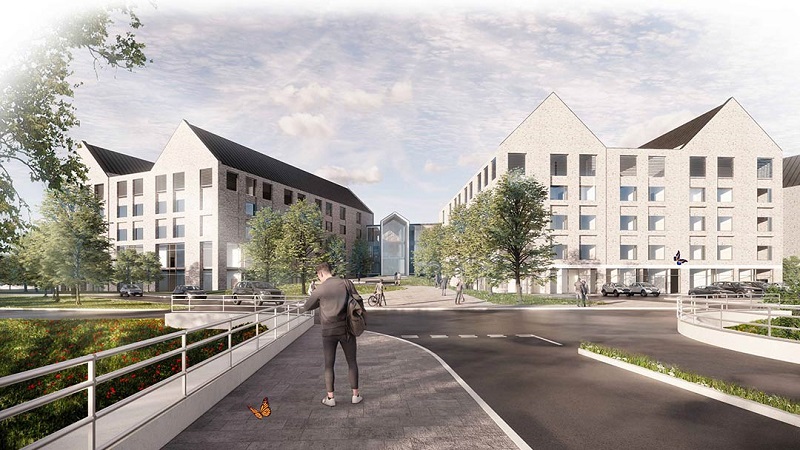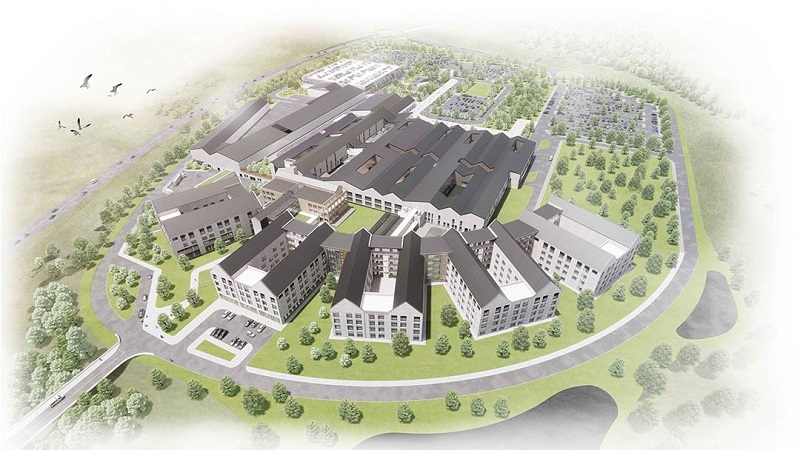NHS bodies across the UK have committed to the drive for all their estates to be carbon ‘net zero’ by 2045 at the latest.
And NHS Scotland is already leading the way, having opened the £65m Balfour Hospital on Orkney last year, the country’s first hospital built to a net-zero standard, which means the running of the building does not contribute to carbon emissions.
And it is following this with the announcement of another new development – University Hospital Monklands – which will be the first to be designed from the very outset to be fully net zero in both the build and operation phases.
A place-making approach
Balfour Hospital, a 15,000sq m scheme, was delivered by Robertson, working with architects, Keppie Design, to a very-specific, bespoke brief from NHS Orkney that required a rural general hospital with particular attention paid to the unique needs of residents.
Designed to put people first and make a positive contribution to the environment, local community, and economy; it is predicated on 'place-making' to give the whole building a depth and level of design missing in many traditional hospitals.
This project demonstrates our commitment that all new NHS Scotland buildings and major refurbishments will be designed to have net-zero greenhouse emissions
It has a large number of small departments and areas, several of which have distinct identities, and an interrelated series of ‘streets’ and spaces arranged around a single central hub.
From this public space, wayfinding is easy and intuitive, and the space is visually connected with external courtyards to further remove the traditional institutional associations.
Weathering any storm
The building accommodates a diverse range of departments designed to be flexible both at user level, supporting complex staffing conditions, and for future expansion and service planning.
Accommodation comprises flexible integrated wards – maternity, palliative care, outpatients, GP practices, dental, emergency department, radiology, pharmacy and labs, operating theatres, and a central decontamination unit as well as a supporting administration centre and public arrival facilities.
Keppie Design became involved in the project in late 2014 and, taking into consideration the exposed site location, the team’s approach responded to the island’s traditional need for its built structures to provide protection and shielding from the extreme weather conditions.
The distinctive curve of the building, therefore, protects the approach to the main entrance spaces and inpatient accommodation.
And its form acts as a reference to the uniqueness of Skara Brae; the stone-built Neolithic settlement located on the Bay of Skaill on the west coast of Mainland, the largest island in the Orkney archipelago.
Keppie Design director, David Ross, said: “Orkney is a richly-diverse environment with drastically-changing colours and textures.
“We sought to embrace and reinforce that in two ways.
“Firstly, the principal form of the main arc has a rigor and simplicity of expression that allows it to be viewed as a backdrop or canvas for these diverse seasonal changes in light and colour.
“Secondly, the areas where people will be in much-closer contact to the building are formed with a rustic and tactile material more in direct relationship with many of the buildings that form Kirkwall’s urban context.”

Balfour Hospital has a nummber of small departments, each with a distinct identity
A community asset
And it also creates opportunities and links to the wider community.
Ross said: “Modern hospitals of this scale are essentially small suburban communities. They are constantly accessible and are active during daytime and quieter during the night.
“The best hospital design understands and embraces this civic morphology.
“They make specific reference to the importance of ‘connected public space and place-making’ as a means of imposing order and identification.
“We believe that this is the way all hospitals should be designed.”
Following an understanding of the correct clinical model and a rigorous analysis of the desired medical adjacencies, the initial design considerations focused on the public realm, with the functional component forming an operational backdrop that makes the quality and coherence of the public spaces the principal characteristic of the building.
“If our cities and towns had uniformity of expression, scale, and proportion, they would be unsuccessful in creating places which have a sustainable resonance for us,” said Ross.
Quality of design
“Similarly, too many hospitals suffer from a lack of consideration for these qualities in the design of their public spaces; the very glue which holds the hospital community together.”
Robertson Specialist Division carried out all external render, providing a brilliant white water and dirt-resistant finish that is suited to the location.
Too many hospitals suffer from a lack of consideration for these qualities in the design of their public spaces; the very glue which holds the hospital community together
To respond to the unique set of challenges Orkney presented, Robertson also considered the remoteness of the island, supply chain logistics, local landscape, and challenging climatic conditions, as well as specific archaeological and environmental considerations.
For example, procuring and shipping construction materials to the island and storing on site well in advance of programme requirements reduced the vulnerability of the project to extreme weather conditions.
And structural steelwork was fabricated offsite wherever possible to enable speedy completion of the building structure.
In addition, the envelope of the building was designed to make best use of trades available on the islands and to achieve an early wind and watertight position, thus allowing internal trades to progress despite any inclement weather.
Net-zero carbon
To achieve its carbon-neutral aims, a fully-electric energy centre features air-to-water heat pumps generating all hot water and electricity, while there are back-up oil generators in case of emergency.
Solar panels also cover the roof to reduce reliance on the Grid. The hospital's maintenance team leader, Paul Bradley, said: “We can produce the hot water needs and offset some of the electrical needs by using Orkney's natural resources.
“Even at low temperatures we can produce heat and hot water, which will help to keep all the patients comfortable during their stay.”
And it is not just the buildings itself that have been designed to be carbon net zero.
Reducing the need for travel has also been taken into account, with the maternity unit scaled up so fewer expectant mothers have to be flown to Aberdeen to give birth.
NHS Orkney also runs a fleet of electric vehicles, is developing green space around the hospital for the benefit of patients and staff, and is sourcing food for the hospital restaurant from local suppliers.

Monklands Hospital will be the first development to be carbon neutral from the earliest design and planning phase
A commitment to the future
Plans for the new University Hospital Monklands were revealed during the COP26 climate summit, held in Glasgow, just 14 miles from the site of the planned facility.
Health secretary, Humza Yousaf, said at the time: “This project demonstrates our commitment that all new NHS Scotland buildings and major refurbishments will be designed to have net-zero greenhouse emissions.
The philosophy that permeates throughout our approach is the creation of an environment for children and adults, like a living, beautiful town where different functional activities fuse together
“The new Monklands Hospital is a key priority and will form part of the Scottish Government’s overall ambition of investing £10billion over the next decade to replace and upgrade health facilities across Scotland.”
Early images of the development, also the work of Keppie Design, show a hospital expertly tailored to the picturesque landscape of the Wester Moffat site on the outskirts of Airdrie.
Graeme Reid, director of the Monklands Replacement Project, said:
“We’re delighted to share this inspirational vision for our new hospital, which is being designed to achieve the Scottish Government’s net-zero requirements.
“The project team is hugely excited about the opportunity we have to provide a world-class hospital for the communities of Lanarkshire.
“It will deliver the most-modern healthcare, designed to ensure that the huge advances in digital technology are central to an improved experience for patients and will help staff carry out their work.
“This ongoing design work was created with the input of patient and public representatives and staff, who have provided very-valuable feedback at a series of workshops.
“And we’ll continue to engage with the community throughout the year.”
Quality control
NHS Lanarkshire is working with the Scottish Government and NHS Scotland Assure – the new service established to assess the quality and management of healthcare construction projects – as it continues to develop the outline business case for the scheme, which is to be submitted to the Scottish Government for approval later this year.
The new Monklands Hospital is a key priority and will form part of the Scottish Government’s overall ambition of investing £10billion over the next decade to replace and upgrade health facilities across Scotland
Ross, said: “The philosophy that permeates throughout our approach is the creation of an environment for children and adults, like a living, beautiful town where different functional activities fuse together.
“Because of the scale of the Monklands brief, it is interesting to consider the split of a large building into separate areas, or districts, each with its own identity and human scale, but unified as part of the ‘town’ plan.”
If given the green light, the hospital is expected to open in 2028.

To achieve its carbon-neutral aims, Monkfields will feature a fully-electric energy centre with air-to-water heat pumps generating all hot water and electricity
Balfour Hospital: Project team
- Investment: Robertson Capital Projects, The Scottish Futures Trust
- Architect: Keppie Design
- Principal contractor: Robertson
- Structural engineer: AECOM
- Building services engineer: Tuv Sud
- Health planning: Capita
- ICT: Boston Networks
- Hard FM and lifecycle maintenance: Robertson Facilities Management
